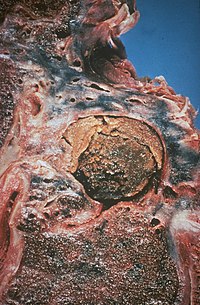
Photo from wikipedia
Objective The aim of this study was to describe clinical features in different subtypes of chronic pulmonary aspergillosis (CPA)-simple aspergilloma (SA), chronic cavitary pulmonary aspergillosis (CCPA), chronic fibrosing pulmonary aspergillosis… Click to show full abstract
Objective The aim of this study was to describe clinical features in different subtypes of chronic pulmonary aspergillosis (CPA)-simple aspergilloma (SA), chronic cavitary pulmonary aspergillosis (CCPA), chronic fibrosing pulmonary aspergillosis (CFPA), aspergillus nodule (AN), and subacute invasive aspergillosis (SAIA), respectively, and identify long-term prognosis of CPA. Methods We reviewed patients diagnosed with different subtypes of CPA from 2002 to 2020 at Nanjing Jinling Hospital, China. We analyzed the clinical and survival information of five different subgroups. A Cox regression model was used to explore proper antifungal duration and long-term survival factors of CCPA and SAIA. Results A total of 147 patients with CPA were included, consisting of 11 SA, 48 CCPA, 5 CFPA, 12 AN, and 71 SAIA. The most common underlying pulmonary disease was pulmonary tuberculosis (n = 49, 33%), followed by bronchiectasis (n = 46, 31.3%) and chronic obstructive pulmonary disease (COPD) or emphysema (n = 45, 30.6%), while in SAIA and CFPA groups, the most common was COPD or emphysema (45.1 and 100%). Cough (85%), expectoration (70.7%), hemoptysis (54.4%), and fever (29.9%) were common symptoms, especially in CCPA, CFPA, and SAIA groups. The common imaging manifestations included cavitation (n = 94, 63.9%), fungal ball (n = 54, 36.7%), pleural thickening (n = 47, 32.0%), and bronchiectasis (n = 46, 31.3%). SAIA and CFPA groups had a lower value of hemoglobin (HB) and serum albumin (ALB) with higher C-reactive protein and erythrocyte sedimentation rate. The positive rate of sputum culture, serum galactomannan (GM), and bronchoalveolar lavage fluid GM was 32.7% (36/110), 18.4% (18/98), and 48.7% (19/39), respectively. There were 64.6% (31/48) patients with CCPA and 25.4% (18/71) patients with SAIA who received surgery and the 5-year cumulative survival rate was 92.1 and 66.6%, respectively. SAIA, old age, male, low body mass index (BMI), COPD or emphysema, multiple distribution, low serum ALB, and positive sputum culture were adverse prognosis factors for SAIA and CCPA group, and BMI ≤ 20.0 kg/m2 was independently associated with increased mortality (hazard ratio (HR) 5.311, 95% CI 1.405–20.068, p = 0.014). Multivariable Cox regression indicated that surgery (HR 0.093, 95% CI 0.011–0.814, p = 0.032) and antifungal duration >6 months (HR 0.204, 95% CI 0.060–0.696 p = 0.011) were related to improved survival. Conclusion The clinical features and laboratory test performance are different among SA, CCPA, CFPA, AN, and SAIA. Low BMI was an independent risk factor for survival. Selective surgery and antifungal duration over 6 months were associated with improved survival.
Journal Title: Frontiers in Medicine
Year Published: 2022
Link to full text (if available)
Share on Social Media: Sign Up to like & get
recommendations!